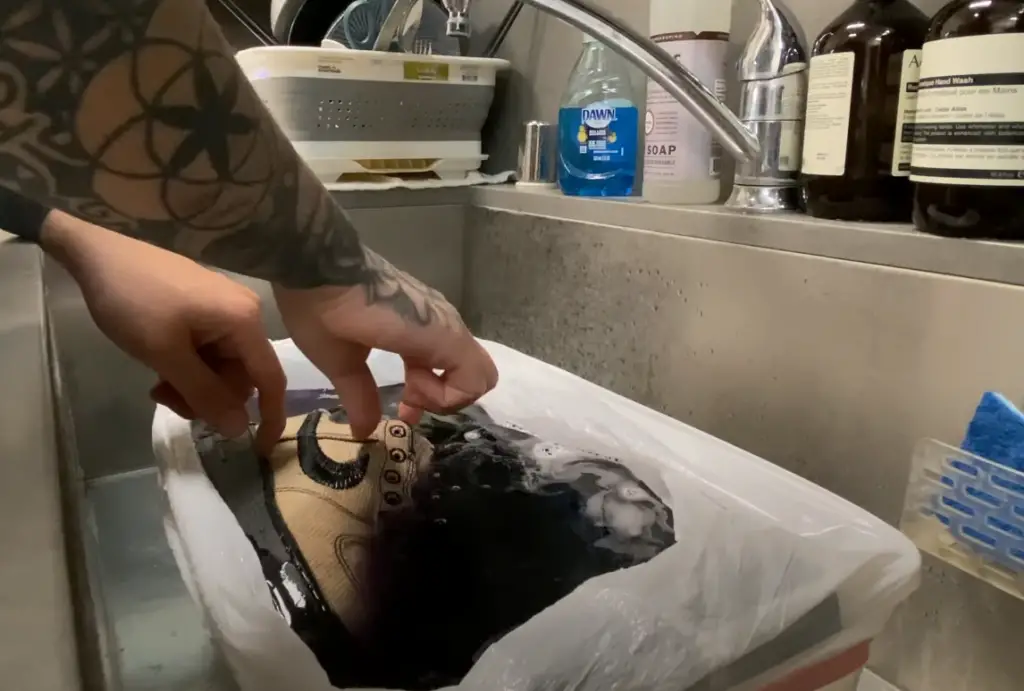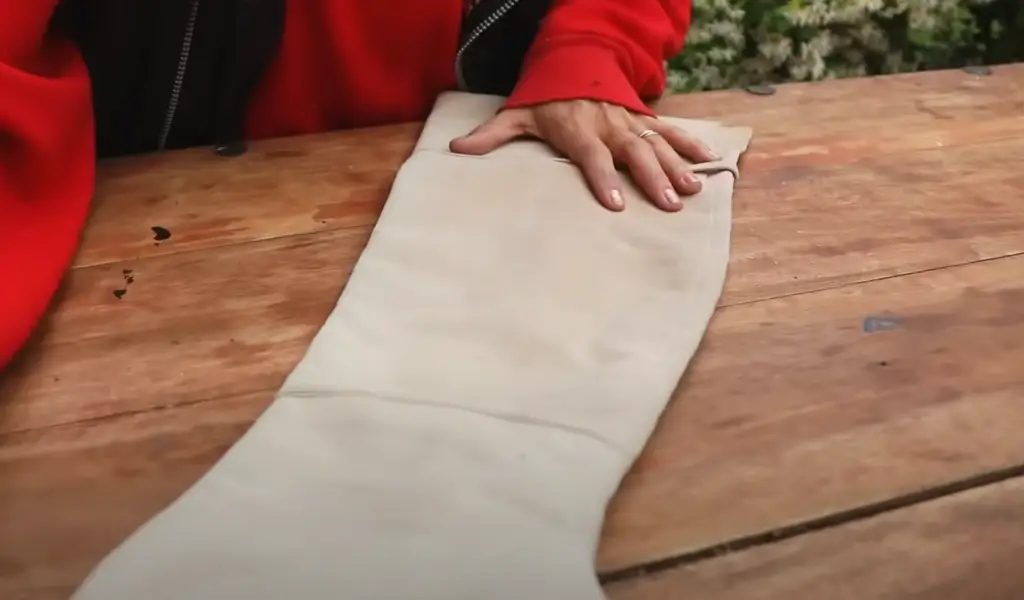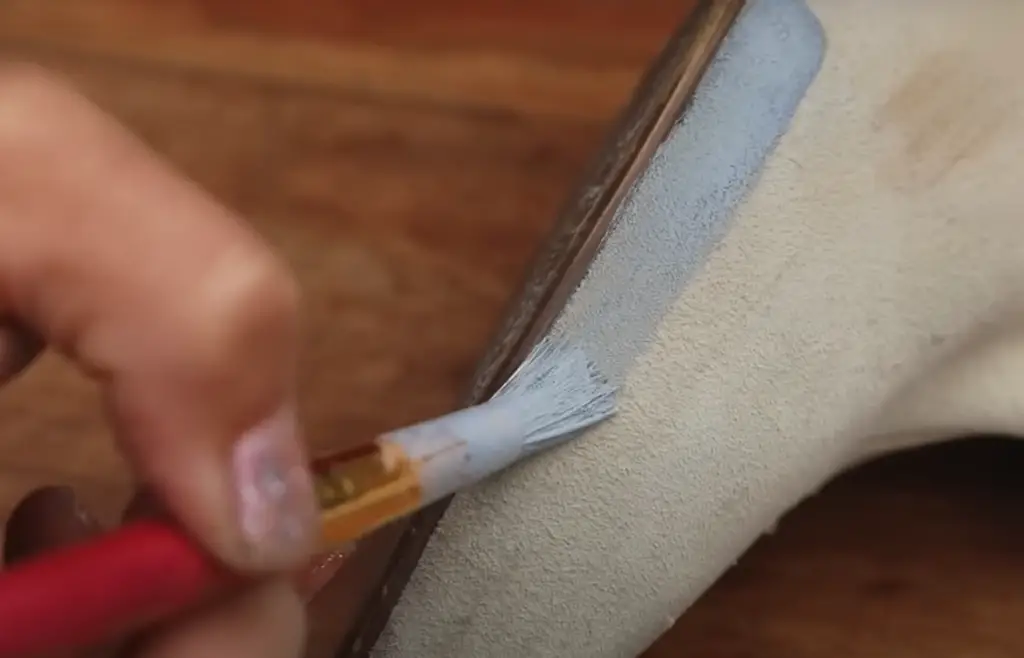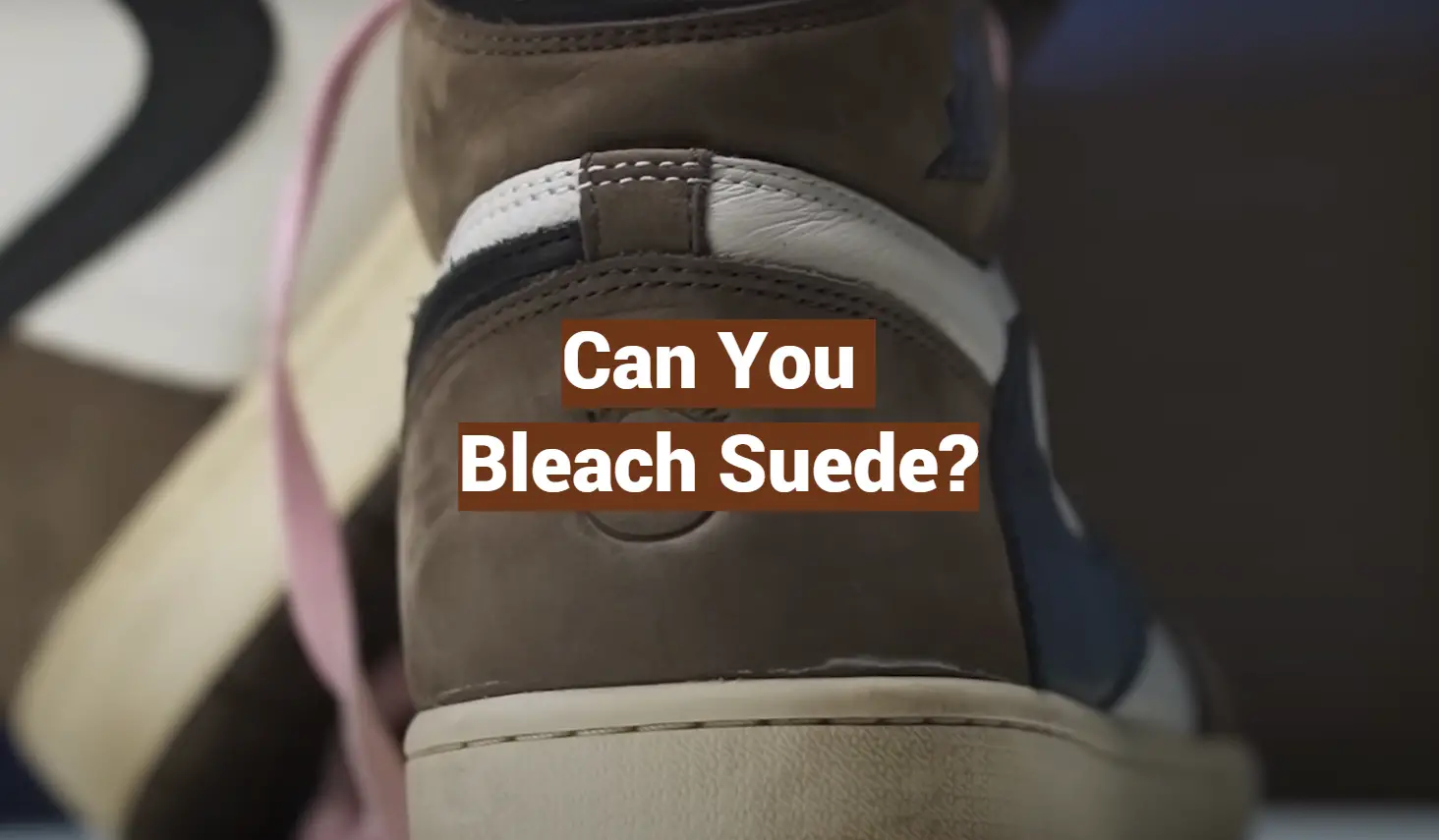Suede is a delicate fabric that often needs special care. Can you bleach suede? What are the risks and benefits? How can you safely bleach suede at home? In this comprehensive guide, we will answer all of your questions about bleaching suede! We’ll provide tips on how to get the best results, as well as warnings about potential dangers. So whether you’re looking to restore an old piece of suede furniture or just want to know how to keep your suede items looking their best, read on for all the information you need!
What is Suede Leather?
Suede leather is a type of leather with a napped finish, giving it a soft, velvety feel. It’s made from the innermost layer of skin, which is why it’s thinner and more delicate than other types of leather.
Despite its delicate nature, suede is a popular choice for clothing, shoes, and furniture because of its unique look and luxurious feel. However, one downside to suede is that it can be difficult to clean and care for.
But sometimes you can’t find the perfect piece of clothing or furniture in the color you want, and you might be tempted to try bleaching suede to get the perfect shade. Suede comes only in a handful of colors naturally, so it’s understandable that you might want to try this. [1]
Can Suede be Bleached?
Bleach is a powerful cleaning agent that is used to remove stains and whiten fabric. It is made up of chemicals that react with the molecules in the stain or fabric, causing them to break down and be removed. Many people use bleach to clean their homes and laundry, but bleaching suede is a different story.

If you do decide to bleach suede, there’s a chance that it will become brittle and cracked. The chemicals in bleach can also break down the natural oils in suede, making it dry and difficult to care for. [2] [3]
Can You Only Clean With Bleach or Also Dye Your Suede White?
So if bleaching suede is a bad idea, what can you do if you want to change the color of your suede item? After all, dyeing suede is a well-known practice.
Unfortunately, if you have a dark piece of suede that you want to dye lighter, you will likely not be successful. This is because the dye will not lighten the color of your suede if the original color is darker. In fact, trying to dye a dark piece of suede lighter can actually make the color uneven and patchy.
But if you have a lighter piece of suede that you want to dye darker, on the other hand, you will likely be successful. Just make sure to use a dye that is made specifically for suede so that you don’t damage the fibers. [2]
How Do You Bleach Suede Leather?
If you insist on bleaching your suede leather, there are a few things you can do to minimize the damage. As long as you take the necessary precautions, you should be able to achieve the desired results without ruining your leather. Just be aware of the risks. In this section, we’ll discuss how to bleach suede leather the right way.
Clean the suede prior to bleaching
You should always clean your leather before bleaching it. This will remove any dirt, oil, or other debris that could potentially interfere with the bleaching process. To clean suede leather, start by vacuuming it with a soft brush attachment. Then, use a slightly damp cloth to wipe down the surface. Finally, allow the leather to air dry completely.
Never bleach dark suede
Dark suede should never be bleached. The chemicals in the bleach will strip away the color of the leather, leaving it looking faded and dull. In some cases, the bleach may even cause the leather to crack and peel. And even if everything goes well, the effects of bleach on suede will be even more unpredictable at best.

Place newspapers underneath your cleaning area
It’s important to place newspapers underneath your bleaching area because, otherwise, the bleach could potentially damage your flooring. By placing newspapers down first, you create a barrier between the bleach and your flooring that will help protect it from any potential damage. You can also use old towels or rags for this purpose.
Work in gloves
When you’re ready to start bleaching, make sure you’re wearing gloves. This will help protect your hands from the harsh chemicals in the bleach. It’s also a good idea to wear old clothes that you don’t mind getting ruined, just in case any bleach spills on them.
Work in a well-ventilated area
Bleach can be very harmful to your lungs, so it’s important to work in a well-ventilated area. If possible, open all the windows and doors in the room to let in as much fresh air as possible. You may even want to consider working outside if the weather permits.
Always dilute bleach
One of the most important things to remember when bleaching suede is to always dilute the bleach. This will help prevent the bleach from damaging the fibers of the leather. To properly dilute bleach, mix one part bleach with four (or more) parts of water.
Test the solution on a small, inconspicuous area first
Before you start bleaching, it’s always a good idea to test the solution on a small, inconspicuous area of the leather. This will give you an idea of how the bleach will react with the suede and whether you need to make any adjustments. Once you’re satisfied with the results, you can proceed with bleaching the rest of the leather.
Wet cotton balls with bleach
Once you’re ready to start bleaching, wet a few cotton balls with the bleach solution. Be sure to wring them out until they’re only slightly damp. You don’t want them to be too wet, or the bleach will run off and potentially damage other areas of the leather.
Apply bleach to the desired area
Gently apply the bleach to the desired area of the leather using the cotton balls. You may need to use more than one cotton ball, depending on the size of the area you’re trying to bleach. Be sure to avoid getting any bleach on other areas of the leather, as this could potentially damage them. Work slowly and in sections to avoid accidentally overlapping. Remove the excess bleach with a clean cloth.

Let the bleach dry
Once you’ve applied the bleach to the desired area, let it dry naturally. This may take anywhere from a few minutes to a few hours, depending on how thick the leather is.
Repeat if necessary
If the results aren’t as light as you’d like them to be, you can always apply another coat of bleach. Just be sure to let the first coat dry completely before applying the second. You may need to repeat this process a few times before you get the desired results.
Apply suede dye
If you intended to dye the leather after bleaching it, now is the time to do so. The suede dye can be applied with a brush or sponge, and it’s best to work in small sections to avoid accidentally overlapping. Once you’re finished, let the dye dry completely before moving on to the next step. Make sure the shoes are properly dry before applying any type of finish.
Re-nap the suede
After the harsh bleaching process, the suede will likely need to be re-napped. This can be done with a suede brush. Be sure to brush in different directions to avoid creating any bald spots. Once you’re finished, the suede should be soft and fluffy once again. You can use a blow-dryer folder while you’re brushing to help speed up the process. [2] [3]
Alternative Methods For Whitening Suede Leather
So by now, you may know that dyeing is a better alternative to lightening for suede shoes since the material is very difficult to lighten evenly. But are there any other methods you can use to achieve a lighter shade? Below are some popular methods:
Use a suede brush
Sometimes it can be that easy! All you need is a suede brush, which can be purchased at any shoe store or online. Suede brushes are designed specifically to lift dirt and debris from the surface of the material without damaging it.
Here’s how to use a suede brush to clean your shoes:
- Start by removing any loose dirt or debris from the surface of your shoes with a soft cloth;
- Gently rub the bristles of the brush over the entire shoe in a circular motion. Be sure to avoid pressing too hard, as this could damage the material;
- Once you’ve gone over the entire shoe, vacuum up any loosened dirt and debris;
- Allow your shoes to air dry completely before wearing them;
Brushing the surface will activate the suede and potentially make it lighter.
Use a sandpaper
If your shoes are made of nubuck or suede, you can use a piece of sandpaper to achieve a lighter shade. Just rub the sandpaper against the material until you’ve achieved the desired color. Be careful not to rub too hard as you don’t want to damage the material.
Use a rosin bag
A rosin bag is a small bag filled with powdered rosin, which is a solid form of resin. It’s commonly used in sports to increase friction, such as in baseball and tennis. Many people also use it as an all-natural deodorant.

To use a rosin bag to lighten your shoes, simply pat the bag over the entire surface of the shoe. The powder will absorb into the leather and help to lighten it. You can find rosin bags online or at most sporting goods stores.
Keep in mind that if you overdo it, you can make your suede way lighter than you wanted. So start with a small amount and work your way up until you get the desired shade.
Use bath powder
This is a method similar to using a rosin bag, but instead of powder, you’ll be using bath powder. To use this method, simply sprinkle the powder over the entire surface of the shoe and rub it in with your fingers. Just make sure the suede surface is completely dry before doing this.
Bath powder is a bit more likely to leave your shoes looking patchy than rosin powder, so be sure to test it on a small area first. You can find bath powder online or at most drugstores. [1]
FAQ
Can you remove the color from the suede?
Yes, you can remove the color from the suede. There are a few ways to do this, but the most common is to use a suede eraser. This will remove the top layer of color and leave the natural color of the suede beneath.
Cleaning stone is another way to remove the color from suede. This method is less common, but it can be effective. First, wet the stone and then rub it over the area of the suede you want to lighten. The stone will absorb the color and leave the natural suede behind.
How do you lighten up suede?
Suede is a delicate fabric, and as such, you have to be careful about how you go about lightening it up. You certainly don’t want to damage the material. The best way to lighten up suede is to use a leather dye. You can find these at most craft stores.
Bleach isn’t recommended for suede, as it can damage the material. If you’re looking to lighten up your suede shoes or clothing, consider using a leather dye instead.

How do you change the color of suede?
Suede can be dyed, but it is a difficult process. First, the suede must be cleaned and then sanded down to remove the existing finish. Next, you will need to apply a dye evenly to the material using a brush. Once the dye has been applied, you will need to let it dry for at least 24 hours before moving on to the next step.
After the dye has dried, you will need to apply a clear sealer to protect the color. You can find these products at most hardware stores or online. Once the sealer has been applied, you will need to let it dry for at least 24 hours before wearing or using the item.
Can you dye suede white?
Yes, you can dye suede white using specialized suede dyes. This process is pretty straightforward and as long as you’re careful, it’s not that difficult to do. You can find these dyes at most craft or fabric stores.
You might be tempted to use bleach on your suede shoes or couch, but we advise against it. Bleach is a harsh chemical and it will damage the delicate suede fibers. It’s best to avoid bleaching suede altogether.
If you’re set on using bleach, then you’ll need to take some extra precautions. First, test the bleach on a small hidden area of the suede to make sure it won’t cause too much damage. Second, dilute the bleach with water before applying it to the fabric. And finally, be very careful when handling the bleach-soaked fabric so you don’t cause any further damage.
Useful Video: How to Bleach and Dye the Stussy x Nike – Air Force 1s
Conclusion
Sometimes your suede shoes or clothing just need a little bit of a refresher. Whether you accidentally spill coffee on them or they start to look a little dull, you might be wondering if you can bleach suede. After all, bleach is a powerful cleaning agent that can brighten up many different types of materials.
The answer is: it depends. While you can technically bleach suede, it’s not always the best idea. Bleach can damage the material, making it more susceptible to tearing and discoloration. It’s also difficult to control how much bleaching agent gets on the suede, so you run the risk of ruining the item if you’re not careful.
If you do decide to bleach suede, we recommend diluting the bleach with water and testing it on a small, hidden area first. This will help you gauge how the suede reacts to the bleaching agent and allow you to avoid any major disasters.
We also covered the alternative suede lightening methods in case you’re not comfortable with using bleach. These include using bath powder or cornstarch to absorb oil and dirt, as well as using a suede brush to activate the suede the natural way. So there you have it! We hope this guide was helpful in answering your question. Thanks for reading!
References:
- https://oureverydaylife.com/flavor-white-cake-mix-lemonade-36909.html
- https://sewingiscool.com/can-you-bleach-suede-how-to/
- https://www.ehow.com/how_10002243_remove-leather-shoe-dye-acetone.html







I’ve tried bleaching suede a few times in the past to lighten up a pair of boots or shoes, and I don’t recommend it. The bleach can really damage and dry out the suede, leaving it cracked and discolored. It’s best to use specialty suede cleaners and lighteners if you want to brighten up the material. Bleach is just too harsh for delicate suede.
When I first got my suede jacket, I accidentally got pizza grease on the sleeve. I panicked and tried using some bleach to remove the stain. Big mistake! It completely ruined and discolored the suede. I learned the hard way that bleach is too abrasive for suede and can damage the delicate fabric. Stick to gentler suede cleaners instead.
I’ll admit I’ve Googled “how to lighten suede” in the past when my suede purse started to look dingy. The internet said bleach could work, but thank goodness I didn’t try it. After researching more, I found that bleach actually yellows and dries out suede. I ended up using a suede cleaner and eraser that gently lifted the dirt without damaging the material.
When I was younger, I bleached a pair of suede shoes in an effort to clean them. I thought the bleach would act like it does on regular cloth and make them look brand new. Wrong! The suede ended up dried out and cracked with discolored blotches. I had to throw the shoes out and learned a lesson – never bleach suede.
Last year, I made the mistake of trying to bleach a suede jacket that had some mildew stains on it. I figured the bleach would sanitize the jacket and remove the stains. Unfortunately, it completely ruined the suede and made it all stiff and discolored. I had to toss the jacket after that experiment. Don’t make my same mistake!
I used to wear suede boots all the time in high school. When they started looking dirty, I actually bleached them trying to clean up the suede. It was a disaster! The bleach completely dried them out and bleached splotches into the boots. I had to throw them away and never bleached suede again.
When I got a suede purse as a gift, I wanted to clean it up a bit before using it. I made the horrible decision to try bleaching a small spot inside thinking it would brighten up the suede. I learned quickly that bleach damages and discolors suede. Just use a suede brush and eraser instead!
Last winter, I wore my suede ankle booties nonstop. Once spring hit, they were looking a little dingy and rough. I contemplated bleaching them to freshen up the suede. After some Googling, I realized bleach can ruin suede, making it dried out and blotchy. I used a suede cleaner instead and the boots turned out great.
I used to have a really nice pair of vintage suede shoes that I adored. After years of wear, they started to look a little dirty and worn. I made the mistake of dabbing some bleach onto the toes thinking I could refresh the color a bit. The bleach left yellow stains and dried out the suede terribly. Those shoes quickly went into the trash – lesson learned!
When I was in college, I had a pair of suede boots that got soaked in a rainstorm. They dried all stiff and misshapen. In a desperate attempt to soften them back up, I used some diluted bleach. Not only did it not help at all, but it left the suede all cracked and discolored. I had to toss the ruined boots after that failed experiment.
I used bleach on an old suede vest last year, thinking it would remove the grime and make it look new. But the bleach completely ruined the suede! It made it super dried out, stiff and cracked. The color got all blotchy too from the harsh chemicals. I definitely don’t recommend using bleach on suede – stick to specialty cleaners made for the delicate material.
I once tried using bleach on an old suede purse to try to remove some mildew stains. It was a bad idea! The bleach damaged the suede badly, leaving discolored patches and making it all dried out. I had to throw out the purse after that. When it comes to suede, it’s best not to use harsh chemicals like bleach at all. Gentler cleaners are better for suede.